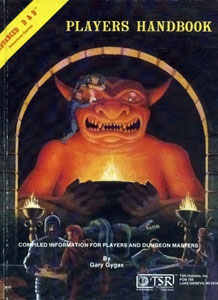
The Player's Handbook is the name given to one of the core rulebooks in every edition of the fantasy role-playing game Dungeons & Dragons (D&D). It does not contain the complete set of rules for the game, and only includes rules for use by players of the game. Additional rules, for use by Dungeon Masters (DMs), who referee the game, can be found in the Dungeon Master's Guide. Many optional rules, such as those governing extremely high-level players, and some of the more obscure spells, are found in other sources.
Dream Pod 9 (DP9), formerly Ianus Games, is a Montreal-based Canadian game publisher. Its most notable products are Heavy Gear, Jovian Chronicles, Tribe 8, and Gear Krieg, as well as the Silhouette role-playing game system.

Fate is a generic role-playing game system based on the Fudge gaming system. It has no fixed setting, traits, or genre and is customizable. It is designed to offer minimal obstruction to role-playing by assuming players want to make fewer dice rolls.

D&D Adventurers League is the organized play association for the Dungeons & Dragons (D&D) roleplaying game which is officially administered by D&D's publisher, Wizards of the Coast. It was rebranded with the launch of D&D's 5th Edition in 2014. Prior to 2014, it was known as the Role Playing Game Association Network. The organization was originally established by D&D's previous publisher, TSR, Inc., in 1980.

Green Ronin Publishing is an American company based in Seattle, Washington. Founded in 2000 by Chris Pramas and Nicole Lindroos, they have published several role-playing game–related products. They won several awards for their games including multiple Origins, ENnie, Pen & Paper, and Inquest Fan Awards.
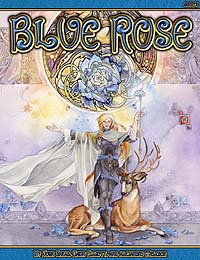
Blue Rose is a fantasy role-playing game published by Green Ronin Publishing in 2005. The game is in the romantic fantasy genre, inspired by fantasy fiction such as that of Mercedes Lackey and Diane Duane as opposed to Conan the Barbarian–style swords and sorcery, and uses a derivative of the D20 system called True20. Blue Rose is notable for being the first role-playing game to explicitly accept characters of all genders and sexual orientations as well as romantic relationships between any two or more characters who are adults.

True20 is a role-playing game system designed by Steve Kenson and published by Green Ronin Publishing. The system was first published as a part of the Blue Rose RPG before being published as a standalone universal generic role-playing game, True20 Adventure Roleplaying.
Paizo Inc. is an American role-playing game publishing company based in Redmond, Washington, best known for the tabletop role-playing games Pathfinder and Starfinder. The company's name is derived from the Greek word παίζωpaizō, which means 'I play' or 'to play'. Paizo also runs an online retail store selling role-playing games board games, comic books, toys, clothing, accessories and other products, as well as an Internet forum community.

Japanese-made tabletop role-playing games first emerged during the 1980s. Instead of "tabletop," they are referred to in Japanese as tabletalk RPGs, a wasei-eigo term meant to distinguish them from role-playing video games, which are popular in Japan. Today, there are hundreds of Japanese-designed tabletop role-playing games as well as games translated into Japanese.
Dragon Age is a media franchise centered on a series of fantasy role-playing video games created and developed by BioWare, which have seen releases on the Xbox 360, PlayStation 3, Microsoft Windows, OS X, PlayStation 4, and Xbox One. The franchise takes place on the fictional continent Thedas, and follows the experiences of its various inhabitants.

Chris Pramas is an American game designer and writer, as well as a founder of Green Ronin Publishing. He is best known as the designer of the Dragon Age RPG, Warhammer Fantasy Roleplay, and Freeport: The City of Adventure.

Ray Winninger is a game designer who has worked on a number of roleplaying games, including the Dungeons & Dragons fantasy roleplaying game. He is the former Executive Producer for the Wizards of the Coast Dungeons & Dragons studio.

A tabletop role-playing game, also known as a pen-and-paper role-playing game, is a kind of role-playing game (RPG) in which the participants describe their characters' actions through speech and sometimes movements. Participants determine the actions of their characters based on their characterization, and the actions succeed or fail according to a set formal system of rules and guidelines, usually involving randomization. Within the rules, players have the freedom to improvise, and their choices shape the direction and outcome of the game.
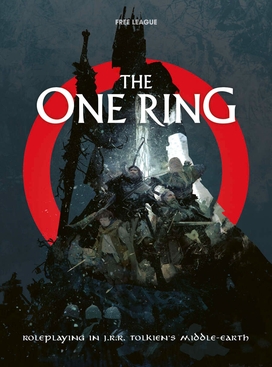
The One Ring Roleplaying Game is a tabletop role-playing game set in J. R. R. Tolkien's Middle-earth, set at the time between The Hobbit and The Lord of the Rings. Designed by Francesco Nepitello and Marco Maggi, the game was initially published by Cubicle 7 in 2011 under the title The One Ring: Adventures over the Edge of the Wild. Cubicle 7 continued to publish the first edition of the game until 2019. Nepitello and Maggi developed the second edition, which is published by Free League Publishing under the same title, The One Ring Roleplaying Game.
The Star Wars Roleplaying Game is a tabletop role-playing game set in the Star Wars universe, first published by Fantasy Flight Games in 2012. It consists of different standalone cross-compatible games where each one is a separate themed experience. The sourcebooks support games set from the Clone Wars era to the original Star Wars trilogy era; there is limited support for the Star Wars sequel trilogy era. Since 2020, the game line has been maintained by Asmodee's subsidiary Edge Studio.

Ork! The Roleplaying Game is a role-playing game published by Green Ronin Publishing in 2000.
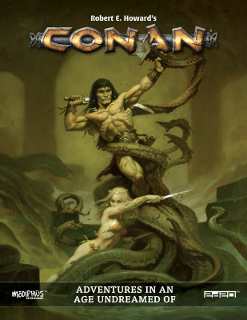
Robert E. Howard's Conan: Adventures in an Age Undreamed Of is a sword and sorcery pen-and-paper role-playing game set in the world of Conan the Barbarian, the fictional Hyborian Age. Both the character and the setting were first imagined by author Robert E. Howard. Howard's original literary work has since spawned a vast franchise of novels, comic books, films, video games, board games, role-playing games, etc. Following this tradition, Conan: Adventures in an Age Undreamed Of is the third officially licensed Conan role-playing game. The two precedent games were Conan Role-Playing Game (1985–1988) and Conan: The Roleplaying Game (2004–2010), although there also had been supplements for independent generic systems, like GURPS Conan (1988–1989).
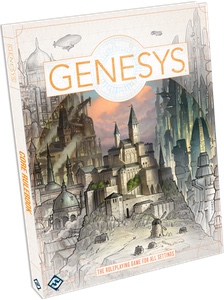
The Genesys Roleplaying Game is a tabletop role-playing game released by Fantasy Flight Games in November 2017. The book presents a generic version of a narrative dice system introduced previously in Fantasy Flight Games' Star Wars RPG, opening the system to be used in any type of setting.

Critical Role: Tal'Dorei Campaign Setting is a sourcebook that details the continent of Tal'Dorei from the Critical Role campaign setting for the 5th edition of the Dungeons & Dragons fantasy role-playing game. It was published by Green Ronin Publishing and released on August 17, 2017; however, it is not considered "official" Dungeons & Dragons material. A revised edition, titled Tal'Dorei Campaign Setting Reborn, was published by Darrington Press and released on January 18, 2022.














